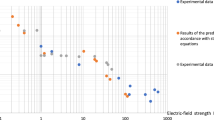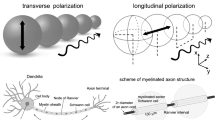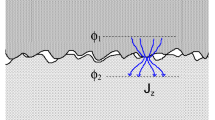Abstract
The distribution of membrane current in three models of nerve, when a longitudinal, linearly increasing current is applied, is derived. For the simple core conductor model it is shown that, if the region over which such a current is applied is large compared to the space constant of the model, the membrane current in the mid-portion of the region is a constant, independent of the distance, the time following the application of the current, and the impedance of the membrane. The effect of nonlinear membrane electrical properties is discussed. It is further shown that these conclusions apply equally to the case in which the simple model is surrounded by another concentric sheath (the double cable model). In this case the impedance of the sheath does not influence the membrane current in the mid-polar region. Finally, it is shown that the form of the solution for the saltatory model, for this type of applied current, is identical with that for the simple model.
Similar content being viewed by others
Literature
Bishop, G. H., J. Erlanger and H. S. Gasser. 1926. “Distortion of Action Potentials as Recorded from the Nerve Surface”.Am. Jour. Physiol.,78, 592–609.
Campbell, G. A. and R. M. Foster. 1942.Fourier Integrals for Practical Applications. New York: Am. Tel. & Tel. Co.
Churchill, Ruel V. 1944.Modern Operational Mathematics in Engineering. New York: McGraw-Hill Co. Inc.
Cole, Kenneth S. 1949. “Some Physical Aspects of Bioelectric Phenomena”.Proc. Nat. Acad. Sci.,35, 558–66.
Cole, K. S. and H. J. Curtis. 1940. “Membrane Potential of the Squid Giant Axon during Current Flow”.Jour. Gen. Physiol.,24, 551–63.
Cremer, M. 1929. “Erregungsgesetz des Nerven”,Hand. d. norm. u. pathol. Physiol.,9, 244–84.
Crescitelli, Frederick. 1951. “Nerve Sheath as a Barrier to the Action of Certain Substances”.Am. Jour. Physiol.,166, 229–40.
Curtis, H. J. and K. S. Cole. 1940. “Membrane Action Potentials from the Squid Giant Axon”.Jour. Cell Comp. Physiol.,15, 147–57.
Hodgkin, A. L. 1947. “The Membrane Resistance of a Non-medullated Nerve Fibre”.Jour. Physiol.,106, 305–18.
Hodgkin, A. L. 1949. “Ionic Exchange and Electrical Activity in Nerve and Muscle”.Arch. des Sci. Physiol.,3, 151–64.
Hodgkin, A. L. and A. F. Huxley. 1939. “Action Potentials Recorded from inside a Nerve Fibre”.Nature,144, 710–11.
Hodgkin, A. L. and W. A. H. Rushton. 1946. “The Electrical Constants of a Crustancean Nerve Fibre”.Proc. Roy. Soc. Lond. B. 133, 444–79.
Hodgkin, A. L., A. F. Huxley and B. Katz. 1949. “Ionic Currents underlying Activity in the Giant Axon of the Squid”.Arch. Sci. Physiol.,3, 129–50.
Huxley, A. F. and R. Stämpfli. 1949. “Evidence for Saltatory Conduction in Peripheral Myelinated Nerve Fibres”,Jour. Physiol. 108, 315–39.
Katz, B. 1948. “The Electrical Properties of the Muscle Fibre Membrane”.Proc. Roy. Soc. Lond. B.,135, 506–34.
Lillie, R. S. 1925. “Factors Affecting the Transmission and Recovery in the Passive Iron Nerve Model”.Jour. Gen. Physiol.,7, 473–507.
Lorente de No, R. 1947.“A Study of Nerve Physiology. I” The Studies from the Rockefeller Institute for Medical Research.,131, New York: Rockefeller Inst.
Marmont, George. 1949. “Studies on the Axon Membrane. I. A New Method”.Jour. Cell. Comp. Physiol.,34, 351–82.
Offner, Franklin, Alvin M. Weinberg and Gale Young. 1940. “Nerve Conduction Theory: Some Mathematical Consequences of Bernstein's Model”.Bull. Math. Biophysics,2, 89–103.
Rashbass, C. and W. A. H. Rushton. 1949. “The Relation of Structure to the Spread of Excitation in the Frog's Sciatic Trunk”.Jour. Physiol.,110, 110–35.
Rashevsky, N. 1948.Mathematical Biophysics, Chicago: University of Chicago Press.
Tables of Probability Functions. 1942. Vol. 2. New York: Works Progress Administration.
Taylor, Robert E. 1950a. “Effect of Polarization on Conduction Velocity of Frog Nerve and Its Modification by KCl”.Fed. Proc.,9, 124.
— 1950b. “Studies of the Effect of Externally Applied Currents on Frog Nerve”. Doctoral Dissertation, University of Rochester, Rochester, New York.
— 1951. “The Absence of Potential Changes during the Contractile Process”.Am. Jour. Physiol. Proc.,167, 831.
Weinberg, A. M. 1941. “Weber's Theory of the Kernleiter”.Bull. Math. Biophysics,3, 39–55.
Author information
Authors and Affiliations
Rights and permissions
About this article
Cite this article
Taylor, R.E. The distribution of membrane current in nerve with longitudinal linearly increasing applied current. Bulletin of Mathematical Biophysics 14, 265–292 (1952). https://doi.org/10.1007/BF02477817
Issue Date:
DOI: https://doi.org/10.1007/BF02477817




